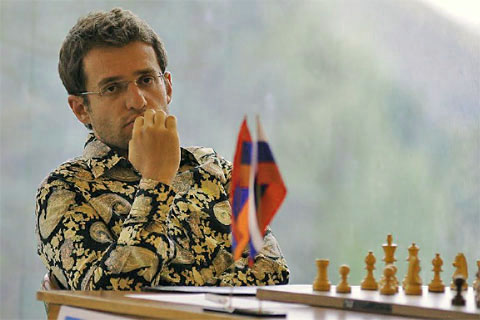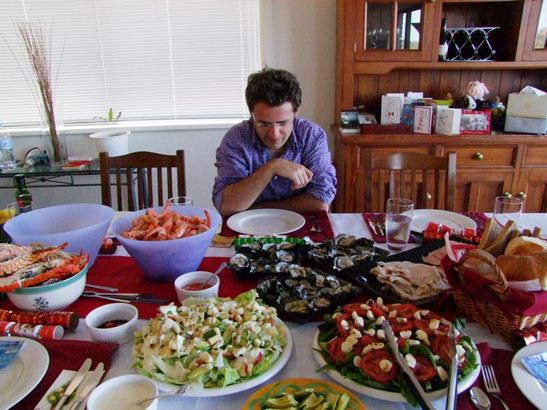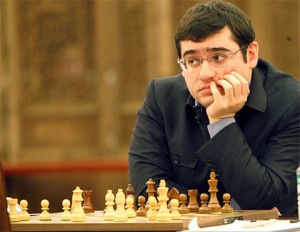From his answer to the very first question on why people play chess, it was clear that Levon Aronian’s Q&A at Crestbook was going to be an entertaining read: “For pleasure, peace of mind and the moral torture of their neighbour”. Sharp and funny, the Armenian GM lifts the lid on life at the top of the chess pyramid.
Aronian was responding to reader questions posed in English here at Chess in Translation and in Russian at the KasparovChess forum. My full translation can now be found at Crestbook (I’ll link again at the end of this short introduction – don’t miss the full version!):
KC-Conference with Levon Aronian
The questions, and most of the answers, were written before the Candidates Matches in Kazan, which of course makes it hard not to regret that Levon didn’t emerge as the challenger to Vishy Anand. Nevertheless, he mentions Boris Gelfand as one of his best grandmaster friends, and in the post-Candidates section at the end adds:
I think Boris deserved this win. He’s a man who treats chess with great reverence, and who works a lot… and is very, you might say, patient with it. You know, it’s easy to work when you can see an immediate return, but he’s had difficult periods, and still to believe in yourself and try to keep working despite that… I’m very, very glad for him, that his dedication and love for the game has borne fruit. This success shows that there’s chess longevity in his blood!

Aronian and Gelfand before the Candidates Matches | photo: FIDE
One of the merits of these in-depth Crestbook interviews is that grandmasters have the chance to set the record straight. In Aronian’s case, for example, you might crudely summarise the preconception of him as being that he’s “an easy-going late-bloomer, who despite his great talent is lazy and tends to win by setting tactical traps for his opponents”. Let’s look at whether that’s true or not!
FACT or MYTH?
1. “A diabolically talented lazy guy”
This phrase comes from Sergey Shipov’s short introductory essay. When asked if he was offended, Aronian responded that it was definitely better than “a diabolically hard-working mediocre guy”. Is there any truth to the statement? The answer would appear to be yes…
As a talented player I always had a great talent for being lazy as well. If it wasn’t for my family (and particularly my mother) and my friends, who did the majority of the work for me, then it’s unlikely I’d have been able to achieve success.
And:
– Can you comment on the widespread opinion that you don’t spend enough time studying chess?
The thing is, that claim used to be true, but in the last two or three years I’ve become more responsible in my approach to my favourite occupation, and started to study chess regularly.
Perhaps the most interesting picture to emerge, however, is that Aronian’s character is representative of a whole school of chess. His wonderful portrait of compatriot Sergei Movsesian includes:
He’s a typical representative of the Caucasus school of chess, which is distinguished by terrifying fighting spirit, natural talent, an absolute ignorance of theory, optimism and incurable laziness. Some (see the best representatives of the school) decided to combat that laziness, while others, like Sergei, have decided to make an effort once every couple of years. Having had a quick glance at the chessboard a couple of years ago he docked in 2750 rating waters, and then decided to go on vacation. Given that recently we’ve been working together I don’t think there’ll be long to wait for a second coming.
Of course “the best representatives of the school” include World Champions Tigran Petrosian and Garry Kasparov.
Verdict: once a FACT, but now becoming a MYTH.
2. “A late developer”
It’s often noted that Levon Aronian is an example of a chess player who disproves the theory that if you haven’t made it to the top (or thereabouts) in chess by the age of 20, you don’t have a hope. He was “only” rated in the mid-2600s at age 21-22, before starting his meteoric rise. However, there was an explanation:
The fact that I was late to cross the 2700-barrier can be explained by the fact that living in Armenia I didn’t have the necessary opportunities for progress, as back then flights to Europe were very expensive, and it was rare at the end of the millennium for young chess players to receive help (in the mid-90s it was incomparably better when it came to sponsorship). If I’d grown up just now then of course I wouldn’t have had such problems, and in fact it might have been the opposite, as it would make sense to move to Armenia in order to develop as a chess player. But after moving to Germany at the end of 2001 I got the opportunity to play in European tournaments, and as a result I was finally able to get down to playing and discovering my potential.
Verdict: FACT, but… as Aronian learned chess at age 9 and then a couple of years later won the Junior World Championship ahead of Bacrot, Ponomariov and Grischuk – it’s not really much comfort for us genuine “late developers”!
3. “A cheap trickster”
One of the most persistent opinions about Levon Aronian is that he relies on tactical tricks far more than most of his elite colleagues. His response to a line of questioning on this “style of play” was amusing, but also suggested he’d heard the opinion expressed once too often!
It’s good to learn that in my play people see such varied techniques that I’ve never noticed myself. Is tricky play my style? If that was true, then I don’t think I’d ever have had the opportunity to tell people about it. The majority of players at the top level use the tactical motifs you call tricks in their play, but I’m sure that in the overwhelming percentage of cases it isn’t done to the detriment of their position.
– How often do you purposefully forgo the most precise move positionally in order to create a subtle trap?
As often as I did in my childhood – only in the inverse proportion.
– And, in your opinion, would such an approach be more or less advisable for players at lower rating levels?
It’s difficult to call that an approach, as against an attentive opponent it’s always doomed to failure. If you’re going to use such ideas when playing against an experienced player then I recommend you wear a colourful outfit and learn to juggle, so as to distract your opponent from your moves.

Now if only I could juggle... | photo: ChessBase
Verdict: MYTH, although Aronian’s joking about himself being a trickster may have been the origin of the myth!
4. “Lacking in fighting spirit”
A Time Magazine article on Magnus Carlsen opened with a memorable description of Vladimir Kramnik:
Tall, handsome and expressionless, he looks exactly as a man who has mastered a game of nearly infinite variation should: like a high-end assassin.
Whatever the accuracy of that description of the ex-World Champion, there’s sometimes a feeling that Aronian is too good-natured. However, that was something he was quick to deny:
I assure you I’ve got more than enough fighting spirit. Without that component I think it would be difficult to win in final rounds, but I’ve managed it on dozens of occasions. The fact that beyond the game I’m benevolent to my opponents disguises that.
I must confess, however, that I mainly added this section as an excuse to include the following quote. Levon is asked to explain the “bloodthirstiness” of his having the lowest draw percentage among elite chess players:
So I’ve been found out. Yes, that’s how I am, and there’s nothing that can be done about it. It’s hard to explain, but I’ll give it a go. I think the thing here is my diet. For 11 years now I haven’t eaten any mammals – although it’s well-known that I’m a person with a bloodthirsty nature. So then, sitting down to play a game and, metaphorically speaking, meeting an animal face-to-face, I experience nostalgia and try to get my fill of blood in those short moments.
Verdict: MYTH is putting it mildly :)

Bloodlust? For more photos from Levon's private collection see the interview at Crestbook!
All that’s left to is to recommend clicking on the following link to read the full interview, which includes a biography, an essay by Sergey Shipov, selected games, and photos provided by Levon himself. Apart from answering questions on all the perennial topics – how computers have changed chess, ratings, the “problem” of draws and so on – surprises include a superb comparison between top chess players and jazz musicians. Unmissable!




Very entertaining, thanks! :-)
Thanks again mishanp and colleagues from Crestbook, as well as Aronian!
You (all) were blissfully unaware of it, but with respect to the second fact or myth, publication of Aronian’s answer to my question is timely in a funny way: It falls in the middle of heated discussions on a German chess blog ( http://www.schach-welt.de ) on several comments by GM Georg Meier. He complained about lack of opportunities in the German chess scene, stating with at least 99% confidence that Giri couldn’t/wouldn’t have realized his potential if he had ended up in Germany rather than the Netherlands. That’s hypothetical, but maybe Meier (while a respectable GM) isn’t quite as talented as Aronian and Giri … .
That multi-author blog tends to be negative most of the time, but the main author IM Löffler is a big fan of Aronian – see, among other examples, the start of his article on the first round of the candidates matches where Aronian was eliminated: “Disgusting. Simply disgusting. And sad.” [“Ekelhaft. Einfach ekelhaft. Und traurig.”]
He was “only” rated in the mid-2600s at age 21-22, before starting his meteoric rise.
Hmm, I thought meteors crashed and burned and became meteorites.
I hope Aronian Doesn’t become a meteor.
Well, fast and brilliant – like a meteor. Although admittedly it’s probably more true just to say Aronian had a steady rise – but to “stratospheric” heights :)
p.s. and if we’re being really strict… “meteor” seems to mean more the trail of light in the sky rather than the object, which is a “meteoroid”.
Ok, Meteoric rise – He made a sudden eye-catching appearance, faded quickly, and made quite an impact in the end. I still hope Aronian doesn’t become a meteor.
Again, I’m not claiming it’s perfect wording… but the point is the “rise” is meteoric, not Aronian’s career. And of course the quick rise in e.g. 2005 did come to a halt – otherwise he’d be at around 3000 just now!
Thomas – I get the feeling discussions in Polish chess circles are quite similar to those in Germany (and maybe they’re the same in almost all federations – not many can really boast of successfully producing star players).
For example, the comments below this blog entry by Jerzy Konikowski (a Polish chess trainer working in Germany) are about the Bundesliga and German chess – with one claim being that the money available meant almost all the players were foreign rather than homegrown.
http://www.blog.konikowski.net/?p=3832
There was a good post about the general problem of developing chess talent (in Poland) by the current Polish Champion, Mateusz Bartel:
http://mateuszbartel.chessbrains.pl/2011/05/31/kozacka-posucha/
e.g.
“Youngsters who play chess are usually intelligent people who face a choice when they finish school – university or chess. That choice is always hard, and usually ends in choosing university, or choosing… university – almost every chess player goes to university. Those who are more focussed on chess don’t, however, take their studies so seriously, while those who let chess take a back seat already start to concentrate on their career, which won’t be connected with the royal game.”
Rather on-topic as Aronian also mentioned the Bundesliga: The fact that it is a strong and rich league is beneficial not just for (young) foreign players – Aronian is one example, another one would be Wojtaszek: Anand “discovered” him and hired him as a second after their Bundesliga game in 2007, then both could be happy with the result of their collaboration. It is, at least in theory, also beneficial to ambitious German players who face the same strong opposition, can earn GM norms (harder to impossible if there were less foreign players), etc. . On the other hand, also “German chess circles” complain that most of the money goes to foreign players, and rather few spots are left for Germans. One reason is that foreign players (from Poland and other Eastern European countries) tend to be cheaper because they need less to earn a living in their home countries – outweighing their travel expenses. Two sides of the very same medal … .
No more off-topic than mishanp’s comment ,:) :
1) On various blogs, the Polish federation was praised for supporting and investing in promising Polish players. As far as I can tell (I have to rely on an awkward Google translation), Konikowski is rather critical – not that they “do something”, but what they do or how they do it.
2) For Georg Meier, the Netherlands seem to be some sort of chess paradise. While I am living there, I cannot really comment because I’m just a humble amateur. But …. a few years ago, Sokolov changed federations (back) to Bosnia because they offered him more money. He was rather frank about it, stating that he felt pity for Dutch players who don’t have such an opportunity, and hoped that his decision would wake up the Dutch federation. Recently, Sokolov changed federations back-back to the Netherlands, reportedly because the Bosnians didn’t or couldn’t fulfill their financial promises.
Somehow in many countries, the grass seems to be greener elsewhere (at least until you take a closer look?).
Thanks for your superb work! (and yes, I like my jazz question.., and the answers; great fun!)
“Cheap trickster” may well be a myth, but I don’t think that was the allegation. The more palatable term “supreme trickster” has be used to characterize Levon’s play. “Cunning” is Shipov’s repeated term. Levon is particularly resourceful at seeing and creating this element of chess – call it what you will. Ths style of play is effective, instructive, and entertaining, and hardly something to be disavowed (unless his denial is also a trick!)
how much longer to P2?
I wouldn’t want to make any predictions :) The Russian version will probably be ready in the next few days and then it could take up to a week to translate – but that could change!
oh…. i thought it’s just a marketing gimmick to post it in parts.
ahem…. everything alright??
Yes, and thanks for asking!
The thing is… I’ve starting working for WhyChess e.g. I translated this Grischuk interview: http://www.whychess.org/node/514 and Tkachiev and other GMs on how to make progress in chess: http://www.whychess.org/node/707 and I summarised Sutovsky’s predictions for the upcoming World Team Championship: http://www.whychess.org/en/node/699
If I wasn’t also trying to translate Part 2 of Aronian’s conference (coming soon, I hope!) I’d still have had some time for specifically Chess in Translation things, though it looks as though that time’s going to be strictly limited from now on. Sadly bills need to be paid :)
Glad that your hobby’s helping you with the bills !! Quite rare, that….
Grischuk: “Generally speaking, I was brought up in the Soviet way and consider that to be absolutely ugly and undignified behaviour, so I’m amazed you find anything whatsoever to admire there. ”
LOL!! I love this guy more and more…. (pity u don’t seem to be credited as well)
i am an indian. one can’t have better plus score in classical chess over Anand and be a ‘cheap trickster’
may be Aronian’s talents are ‘indecipherable’.
definitely a fantastic player that Aronian is!
And a good fellow he looks.
I found this comment from Aronian to be fascinating:
“If in the opening position a player with a rating of 2600 takes away his two central pawns against a player with a 2100 rating, then I don’t think he’ll have any chances of victory, but if you take the two outside pawns, then I think the stronger player will have an edge.”
I set up the positions described in Houdini 1.5, and went 23 ply, and Houdini’s take is:
Opening position with center pawns missing:
23 -1.01 1735.7M 12:30.84 Nf3 Nc6 c4 g6 Nc3 Bg7 Bd3 Nf6 O-O O-O Qe2 d6 h3 Nd7 Be3 Nc5 Bb1 Be6 Rd1 b6 Ng5
Opening position with outer pawns missing:
23 -0.41 711.8M 5:30.76 e4 d6 d4 Nf6 Nc3 g6 Bf4 Bg7 Qd2 h6 O-O-O a6 Kb1 g5 Be3 Ng4 Bc4 Nc6 Nge2 Nxe3 fxe3 b5 Bd5 Bd7 g4
Conclusion: Aronian is talking about a half-pawn difference, between the two described positions, from the machine’s point of view. But maybe the difference in having and not having your center two pawns shows only at a (much) deeper level than 11.5 moves. (Also note, in neither position is there a quick win.) Much food for thought.